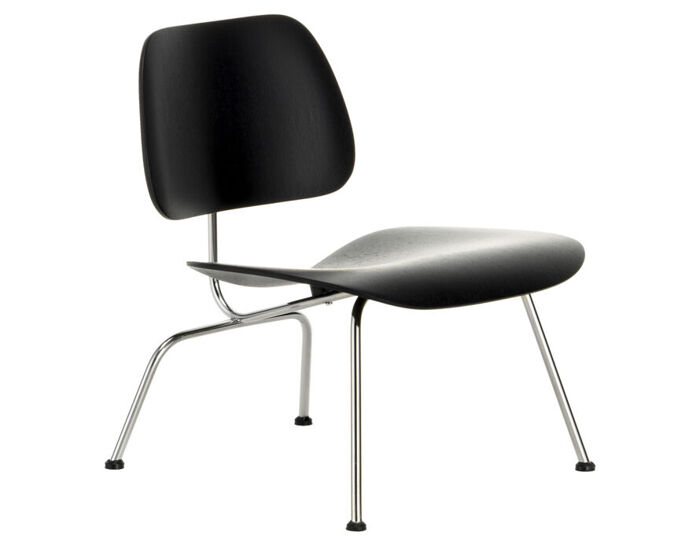miniature eames lcm
Design Charles & Ray Eames, 1945
1/6 miniature scale model
Made in Poland by Vitra
For over two decades, the Vitra Design Museum has been making miniature replicas of milestones in furniture design. The Miniatures Collection encapsulates the entire history of industrial furniture design - moving from Historicism and Art Nouveau to the New Objectivity of Bauhaus and Radical Design, and from Postmodernism all the way up to the present day. Exactly one sixth of the size of the historical originals, the chairs are all true to scale and precisely recreate the smallest details of construction, material and color. The high standard of authenticity even extends to the natural grain of the wood, the reproduction of screws and the elaborate handicraft techniques involved. This has made the miniatures into popular collector's items as well as ideal illustrative material for universities, design schools and architects.
Charles Eames and Eero Saarinen designed a chair in 1940 with a new type of three-dimensional pre-shaped plywood seat for a competition held by the New York Museum of Modern Art. The chair did not go into production owing to a lack of technical know-how. It was very rare back then for plywood to be successfully pressed into a three-dimensional shape. In the years that followed, Charles and Ray Eames concentrated on developing a process that enabled plywood to be shaped as they wanted.
The Plywood Chairs DCW (Dining Chair Wood), LCW (Lounge Chair Wood) and the versions with metal legs, namely DCM (Dining Chair Metal) and LCM were the result of these years of experimentation. In 1945 Charles and Ray Eames again took up the idea of a seat made of formed plywood without, however, coming up with satisfactory solutions. As a consequence, they rejected the idea of a multifunctional seat and decided to treat seat and back as separate, freely articulated elements that were linked with each other via a backbone, the frame. Each component is therefore reduced to a clearly defined function which it fulfills with a minimum of materials being used. The rubber shock mounts glued onto the wood enable the seat and back to be connected to the frame.
Each Vitra miniature is true to the original in construction and materials, and reduced in size on a scale of 1:6. Each miniature is packaged in a wooden box, accompanied by an informational booklet. Production notes: Each of the delicate objects are made by hand; on average, each miniature requires five hours of careful manual work. Ongoing quality control ensures that every miniature corresponds to its larger original in terms of finishing, details and materials.
4.25" h | 3.75" w | 4.25" d
1/6 miniature scale model
Made in Poland by Vitra
For over two decades, the Vitra Design Museum has been making miniature replicas of milestones in furniture design. The Miniatures Collection encapsulates the entire history of industrial furniture design - moving from Historicism and Art Nouveau to the New Objectivity of Bauhaus and Radical Design, and from Postmodernism all the way up to the present day. Exactly one sixth of the size of the historical originals, the chairs are all true to scale and precisely recreate the smallest details of construction, material and color. The high standard of authenticity even extends to the natural grain of the wood, the reproduction of screws and the elaborate handicraft techniques involved. This has made the miniatures into popular collector's items as well as ideal illustrative material for universities, design schools and architects.
Charles Eames and Eero Saarinen designed a chair in 1940 with a new type of three-dimensional pre-shaped plywood seat for a competition held by the New York Museum of Modern Art. The chair did not go into production owing to a lack of technical know-how. It was very rare back then for plywood to be successfully pressed into a three-dimensional shape. In the years that followed, Charles and Ray Eames concentrated on developing a process that enabled plywood to be shaped as they wanted.
The Plywood Chairs DCW (Dining Chair Wood), LCW (Lounge Chair Wood) and the versions with metal legs, namely DCM (Dining Chair Metal) and LCM were the result of these years of experimentation. In 1945 Charles and Ray Eames again took up the idea of a seat made of formed plywood without, however, coming up with satisfactory solutions. As a consequence, they rejected the idea of a multifunctional seat and decided to treat seat and back as separate, freely articulated elements that were linked with each other via a backbone, the frame. Each component is therefore reduced to a clearly defined function which it fulfills with a minimum of materials being used. The rubber shock mounts glued onto the wood enable the seat and back to be connected to the frame.
Each Vitra miniature is true to the original in construction and materials, and reduced in size on a scale of 1:6. Each miniature is packaged in a wooden box, accompanied by an informational booklet. Production notes: Each of the delicate objects are made by hand; on average, each miniature requires five hours of careful manual work. Ongoing quality control ensures that every miniature corresponds to its larger original in terms of finishing, details and materials.
4.25" h | 3.75" w | 4.25" d
Eames
The primary need of the human being was an essential component of every design for Eames. They believed a design to be successful when it benefited the greatest number of people.
Vitra is a Swiss company dedicated to improving the quality of life through the power of design. A central goal of Vitra is sustainable development. Trendy styling is avoided in favor of classic pieces that can be used for decades.













 write a review now
write a review now
